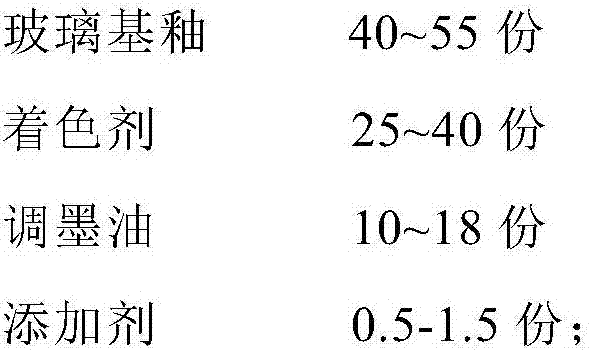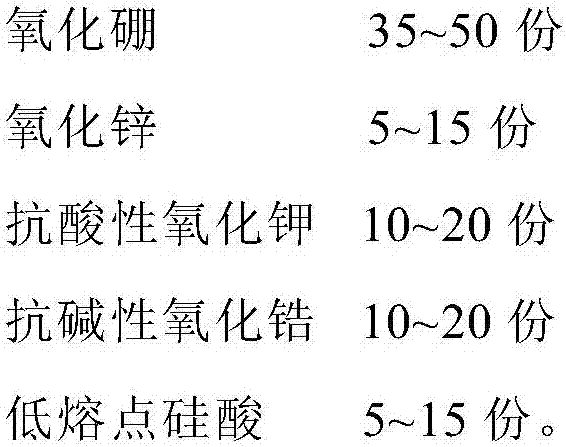Pearlescent printing ink used for glass and preparation method of pearlescent printing ink
A pearlescent ink and glass technology, applied in inks, applications, household appliances, etc., can solve the problems of inability to print, full and thick pearlescent effect, poor ink adhesion, etc., to achieve good wetting, easy operation, and good fluidity performance. and dispersion properties
- Summary
- Abstract
- Description
- Claims
- Application Information
AI Technical Summary
Problems solved by technology
Method used
Image
Examples
Embodiment 1
[0030] Pearlescent ink for glass, prepared using the following steps:
[0031] (1) 10 parts of phenolic resins, 15 parts of rosin resins, 15 parts of vegetable oils and 5 parts of mineral oils are dropped into a stirring device and mixed to obtain a connecting material, which is preserved for subsequent use;
[0032] (2) 25 parts of rosin-modified phenolic resins, 5 parts of water-soluble acrylic resins, 15 parts of hydroxyfluorosilicone resins and 30 parts of solvents are dropped into the stirring device and evenly mixed, and the stirring speed is 1200rpm, and stirred for 30min to obtain the first mixed solution;
[0033] (3) adding 20 parts of pearlescent pigments, the linking material of step (1) and 0.5 part of defoaming agent into the first mixed solution successively and put them into the stirring device, the stirring speed is 700rpm, stirring for 40min, and after adjusting to the required viscosity, obtain mixed material;
[0034] (4) The mixed material is ground and d...
Embodiment 2
[0037] Pearlescent ink for glass, prepared using the following steps:
[0038] (1) 15 parts of phenolic resins, 10 parts of rosin resins, 10 parts of vegetable oils and 10 parts of mineral oils are dropped into a stirring device and mixed to obtain a connecting material, which is preserved for subsequent use;
[0039] (2) 30 parts of rosin-modified phenolic resins, 10 parts of water-soluble acrylic resins, 20 parts of hydroxyfluorosilicone resins and 35 parts of solvents are dropped into the stirring device and evenly mixed, and the stirring speed is 1250rpm, and stirred for 25min to obtain the first mixed solution;
[0040] (3) adding 25 parts of pearlescent pigments, the linking material of step (1) and 1 part of defoaming agent into the first mixed solution successively and put them into the stirring device, the stirring speed is 750rpm, stirring for 35min, and after adjusting to the required viscosity, obtain mixed material;
[0041] (4) The mixed material is ground and d...
Embodiment 3
[0044] Pearlescent ink for glass, prepared using the following steps:
[0045] (1) 20 parts of phenolic resins, 12 parts of rosin resins, 20 parts of vegetable oils and 15 parts of mineral oils are dropped into a stirring device and mixed to obtain a connecting material, which is preserved for subsequent use;
[0046] (2) 40 parts of rosin-modified phenolic resins, 15 parts of water-soluble acrylic resins, 25 parts of hydroxyfluorosilicone resins and 40 parts of solvents are dropped into the stirring device and evenly mixed, the stirring speed is 1300rpm, and stirred for 20min to obtain the first mixed solution;
[0047] (3) adding 30 parts of pearlescent pigments, the linking material of step (1) and 2.5 parts of defoaming agent into the first mixed solution successively and put them into the stirring device, the stirring speed is 800rpm, stirring for 30min, and after adjusting to the required viscosity, obtain mixed material;
[0048] (4) The mixed material is ground and di...
PUM
 Login to View More
Login to View More Abstract
Description
Claims
Application Information
 Login to View More
Login to View More - R&D
- Intellectual Property
- Life Sciences
- Materials
- Tech Scout
- Unparalleled Data Quality
- Higher Quality Content
- 60% Fewer Hallucinations
Browse by: Latest US Patents, China's latest patents, Technical Efficacy Thesaurus, Application Domain, Technology Topic, Popular Technical Reports.
© 2025 PatSnap. All rights reserved.Legal|Privacy policy|Modern Slavery Act Transparency Statement|Sitemap|About US| Contact US: help@patsnap.com



